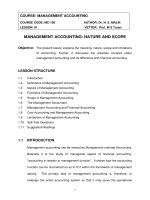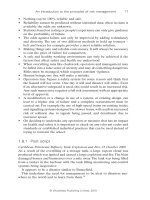Guidelines on Credit Risk Management: Rating Models and Validation doc
Bạn đang xem bản rút gọn của tài liệu. Xem và tải ngay bản đầy đủ của tài liệu tại đây (4.61 MB, 172 trang )
Guidelines on Credit Risk Management
Rating Models
and Validation
≈√
These guidelines were prepared by the Oesterreichische Nationalbank (OeNB)
in cooperation with the Financial Market Authority (FMA)
Published by:
Oesterreichische Nationalbank (OeNB)
Otto Wagner Platz 3, 1090 Vienna, Austria
Austrian Financial Market Authority (FMA)
Praterstrasse 23, 1020 Vienna, Austria
Produced by:
Oesterreichische Nationalbank
Editor in chief:
Gu
‹
nther Thonabauer, Secretariat of the Governing Board and Public Relations (OeNB)
Barbara No
‹
sslinger, Staff Department for Executive Board Affairs and Public Relations (FMA)
Editorial processing:
Doris Datschetzky, Yi-Der Kuo, Alexander Tscherteu, (all OeNB)
Thomas Hudetz, Ursula Hauser-Rethaller (all FMA)
Design:
Peter Buchegger, Secretariat of the Governing Board and Public Relations (OeNB)
Typesetting, printing, and production:
OeNB Printing Office
Published and produced at:
Otto Wagner Platz 3, 1090 Vienna, Austria
Inquiries:
Oesterreichische Nationalbank
Secretariat of the Governing Board and Public Relations
Otto Wagner Platz 3, 1090 Vienna, Austria
Postal address: PO Box 61, 1011 Vienna, Austria
Phone: (+43-1) 40 420-6666
Fax: (+43-1) 404 20-6696
Orders:
Oesterreichische Nationalbank
Documentation Management and Communication Systems
Otto Wagner Platz 3, 1090 Vienna, Austria
Postal address: PO Box 61, 1011 Vienna, Austria
Phone: (+43-1) 404 20-2345
Fax: (+43-1) 404 20-2398
Internet:
Paper:
Salzer Demeter, 100% woodpulp paper, bleached without chlorine, acid-free, without optical whiteners
DVR 0031577
The ongoing development of contemporary r isk management methods and the
increased use of innovative financial products such as securitization and credit
derivatives have brought about substantial changes in the business environment
faced by credit institutions today. Especially in the field of lending, these
changes and innovations are now forcing banks to adapt their in-house software
systems and the relevant business processes to meet these new requirements.
The
OeNB Guidelines on Credit Risk Management
are intended to
assist practitioners in redesigning a bankÕs systems and processes in the course
of implementing the Basel II framework.
Throughout 2004 and 2005, OeNB guidelines will appear on the subjects of
securitization, rating and validation, credit approval processes and management,
as well as credit risk mitigation techniques. The content of these guidelines is
based on current international developments in the banking field and is meant
to provide readers with best practices which banks would be well advised to
implement regardless of the emergence of new regulatory capital requirements.
The purpose of these publications is to develop mutual understanding
between regulatory authorities and banks with regard to the upcoming changes
in banking. In this context, the Oester reichische Nationalbank (OeNB), Aus-
triaÕs central bank, and the Austrian Financial Market Authority (FMA) see
themselves as partners to AustriaÕs credit industry.
It is our sincere hope that the OeNB Guidelines on Credit Risk Management
provide interesting reading as well as a basis for efficient discussions of the cur-
rent changes in Austrian banking.
Vienna, November 2004
Univ. Doz. Mag.Dr. Josef Christl
Member of the Governing Board
of the Oesterreichische Nationalbank
Dr. Kurt Pribil,
Dr. Heinrich Traumu
‹
ller
FMA Executive Board
Preface
Guidelines on Credit Risk Management 3
I INTRODUCTION
7
II ESTIMATING AND VALIDATING PROBABILITY
OF DEFAULT (PD)
8
1 Defining Segments for Credit Assessment
8
2 Best-Practice Data Requirements for Credit Assessment
11
2.1 Governments and the Public Sector 12
2.2 Financial Service Providers 15
2.3 Corporate Customers — Enterprises/Business Owners 17
2.4 Corporate Customers — Specialized Lending 22
2.4.1 Project Finance 24
2.4.2 Object Finance 25
2.4.3 Commodities Finance 26
2.4.4 Income-Producing Real Estate Financing 26
2.5 Retail Customers 28
2.5.1 Mass-Market Banking 28
2.5.2 Private Banking 31
3 Commonly Used Credit Assessment Models
32
3.1 Heuristic Models 33
3.1.1 ÒClassicÓ Rating Questionnaires 33
3.1.2 Qualitative Systems 34
3.1.3 Expert Systems 36
3.1.4 Fuzzy Logic Systems 38
3.2 Statistical Models 40
3.2.1 Multivariate Discriminant Analysis 41
3.2.2 Regression Models 43
3.2.3 Artificial Neural Networks 45
3.3 Causal Models 48
3.3.1 Option Pricing Models 48
3.3.2 Cash Flow (Simulation) Models 49
3.4 Hybrid Forms 50
3.4.1 Horizontal Linking of Model Types 51
3.4.2 Vertical Linking of Model Types Using Overrides 52
3.4.3 Upstream Inclusion of Heuristic Knock-Out Criteria 53
4 Assessing the ModelsÕ Suitability for Various Rating
Segments
54
4.1 Fulfillment of Essential Requirements 54
4.1.1 PD as Target Value 54
4.1.2 Completeness 55
4.1.3 Objectivity 55
4.1.4 Acceptance 56
4.1.5 Consistency 57
4.2 Suitability of Individual Model Types 57
4.2.1 Heuristic Models 57
4.2.2 Statistical Models 58
4.2.3 Causal Models 60
Contents
4 Guidelines on Credit Risk Management
5 Developing a Rating Model
60
5.1 Generating the Data Set 62
5.1.1 Data Requirements and Sources 62
5.1.2 Data Collection and Cleansing 64
5.1.3 Definition of the Sample 72
5.2 Developing the Scoring Function 82
5.2.1 Univariate Analyses 75
5.2.2 Multivariate Analysis 80
5.2.3 Overall Scoring Function 82
5.3 Calibrating the Rating Model 84
5.3.1 Calibration for Logistic Regression 85
5.3.2 Calibration in Standard Cases 86
5.4 Transition Matrices 88
5.4.1 The One-Year Transition Matrix 88
5.4.2 Multi-Year Transition Matrices 91
6 Validating Rating Models
94
6.1 Qualitative Validation 96
6.2 Quantitative Validation 98
6.2.1 Discriminatory Power 98
6.2.2 Back-Testing the Calibration 115
6.2.3 Back-Testing Transition Matr ices 132
6.2.4 Stability 134
6.3 Benchmarking 128
6.4 Stress Tests 130
6.4.1 Definition and Necessity of Stress Tests 130
6.4.2 Essential Factors in Stress Tests 131
6.4.3 Developing Stress Tests 133
6.4.4 Performing and Evaluating Stress Tests 137
III ESTIMATING AND VALIDATING LGD/EAD
AS RISK COMPONENTS
139
7 Estimating Loss Given Default (LGD)
139
7.1 Definition of Loss 140
7.2 Parameters for LGD Calculation 140
7.2.1 LGD-Specific Loss Components in Non-Retail Transactions 140
7.2.2 LGD-Specific Loss Components in Retail Transactions 143
7.3 Identifying Information Carriers for Loss Parameters 144
7.3.1 Information Carriers for Specific Loss Parameters 144
7.3.2 Customer Types 146
7.3.3 Types of Collateral 148
7.3.4 Types of Transaction 149
7.3.5 Linking of Collateral Types and Customer Types 150
7.4 Methods of Estimating LGD Parameters 151
7.4.1 Top-Down Approaches 151
7.4.2 Bottom-Up Approaches 153
7.5 Developing an LGD Estimation Model 157
Contents
Guidelines on Credit Risk Management 5
8 Estimating Exposure at Default (EAD)
162
8.1 Transaction Types 162
8.2 Customer Types 163
8.3 EAD Estimation Methods 165
IV REFERENCES
167
V FURTHER READING
170
Contents
6 Guidelines on Credit Risk Management
I INTRODUCTION
The OeNB Guideline on Rating Models and Validation was created within a ser-
ies of publications produced jointly by the Austrian Financial Markets Authority
and the Oesterreichische Nationalbank on the topic of credit risk identification
and analysis. This set of guidelines was created in response to two important
developments: First, banks are becoming increasingly interested in the contin-
ued development and improvement of their risk measurement methods and
procedures. Second, the Basel Committee on Banking Supervision as well as
the European Commission have devised regulatory standards under the heading
ÒBasel IIÓ for banksÕ in-house estimation of the loss parameters probability of
default (PD), loss given default (LGD), and exposure at default (EAD). Once
implemented appropriately, these new regulatory standards should enable banks
to use IRB approaches to calculate their regulatory capital requirements, pre-
sumably from the end of 2006 onward. Therefore, these guidelines are intended
not only for credit institutions which plan to use an IRB approach but also for all
banks which aim to use their own PD, LGD, and/or EAD estimates in order to
improve assessments of their risk situation.
The objective of this document is to assist banks in developing their own
estimation procedures by providing an overview of current best-practice
approaches in the field. In particular, the guidelines provide answer s to the fol-
lowing questions:
— Which segments (business areas/customers) should be defined?
— Which input parameters/data are required to estimate these parameters in a
g iven segment?
— Which models/methods are best suited to a given segment?
— Which procedures should be applied in order to validate and calibrate mod-
els?
In part II, we present the special requirements involved in PD estimation
procedures. Fir st, we discuss the customer segments relevant to credit assess-
ment in chapter 1. On this basis, chapter 2 covers the resulting data require-
ments for credit assessment. Chapter 3 then briefly presents credit assessment
models which are commonly used in the market. In Chapter 4, we evaluate
these models in terms of their suitability for the segments identified in chap-
ter 1. Chapter 5 discusses how rating models are developed, and part II con-
cludes with chapter 6, which presents information relevant to validating estima-
tion procedures. Part III provides a supplement to Part II by presenting the spe-
cific requirements for estimating LGD (chapter 7) and EAD (chapter 8). Addi-
tional literature and references are provided at the end of the document.
Finally, we would like to point out that these guidelines are only intended to
be descriptive and informative in nature. They cannot (and are not meant to)
make any statements on the regulatory requirements imposed on credit institu-
tions dealing with rating models and their validation, nor are they meant to
prejudice the regulatory activities of the competent authorities. References to
the draft EU directive on regulatory capital requirements are based on the latest
version available when these guidelines were written (i.e. the draft released on
July 1, 2003) and are intended for information purposes only. Although this
document has been prepared with the utmost care, the publishers cannot
assume any responsibility or liability for its content.
Rating Models and Validation
Guidelines on Credit Risk Management 7
II ESTIMATING AND VALIDATING
PROBABILITY OF DEFAULT (PD)
1 Defining Segments for Credit Assessment
Credit assessments are meant to help a bank measure whether potential bor row-
er s will be able to meet their loan obligations in accordance with contractual
agreements. However, a credit institution cannot perform credit assessments
in the same way for all of its borrowers.
This point is supported by three main arguments, which will be explained in
g reater detail below:
1. The factors relevant to creditworthiness vary for different borrower types.
2. The available data sources vary for different borrower types.
3. Credit risk levels vary for different borrower types.
Ad 1.
Wherever possible, credit assessment procedures must include all data and
information relevant to creditworthiness. However, the factors determining cre-
ditworthiness will vary according to the type of borrower concerned, which
means that it would not make sense to define a uniform data set for a bankÕs
entire credit portfolio. For example, the credit quality of a government depends
largely on macroeconomic indicators, while a company will be assessed on the
basis of the quality of its management, among other things.
Ad 2.
Completely different data sources are available for various types of borrowers.
For example, the bank can use the annual financial statements of companies
which prepare balance sheets in order to assess their credit quality, whereas this
is not possible in the case of retail customers. In the latter case, it is necessary to
gather analogous data, for example by requesting information on assets and lia-
bilities from the customers themselves.
Ad 3.
Empirical evidence shows that average default rates vary widely for different
types of borrowers. For example, governments exhibit far lower default rates
than business enterprises. Therefore, banks should account for these
varying lev-
els of risk
in credit assessment by segmenting their credit portfolios accordingly.
This also makes it possible to adapt the intensity of credit assessment according
to the risk involved in each segment.
Segmenting the credit portfolio is thus a basic prerequisite for assessing the
creditworthiness of all a bankÕs borrowers based on the specific risk involved.
On the basis of
business considerations, we distinguish between the following
general segments in practice:
— Governments and the public sector
— Financial service providers
— Corporate customers
¥ Enterprises/business owners
¥ Specialized lending
— Retail customers
Rating Models and Validation
8 Guidelines on Credit Risk Management
This segmentation from the business perspective is generally congruent with
the
regulatory categorization of assets in the IRB approach under Basel II and the
draft EU directive:
1
— Sovereigns/central governments
— Banks/institutions
— Corporates
¥ Subsegment: Specialized lending
— Retail customers
— Equity
Due to its highly specific characteristics, the equity segment is not discussed
in detail in this document.
However, as the above-mentioned general segments themselves are gener-
ally not homogeneous, a more
specific segmentation is necessary (see chart 1).
One conspicuous feature of our best-practice segmentation is its inclusion of
product elements in the retail customer segment. In addition to borrower-spe-
cific creditworthiness factors, transaction-specific factors are also attributed
importance in this segment. Further information on this special feature can
be found in Section 2.5, Retail Customers, where in particular its relationship
to Basel II and the draft EU directive is discussed.
1
EUROPEAN COMMISSION, draft directive on regulatory capital requirements, Article 47, No. 1—9.
Rating Models and Validation
Guidelines on Credit Risk Management 9
Chart 1: Best-Practice Segmentation
Rating Models and Validation
10 Guidelines on Credit Risk Management
The best-practice segmentation presented here on the basis of individual
loans and credit facilities for retail customers reflects customary practice in
banks, that is, scoring procedures for calculating the PD of individual customers
usually already exist in the retail customer segment.
The draft EU directive contains provisions which ease the burden of risk
measurement in the retail customer segment. For instance, retail customers
do not have to be assessed individually using rating procedures; they can be
assigned to pools according to specific borrower and product characteristics.
The risk components PD, LGD, and EAD are estimated separately for these
pools and then assigned to the individual borrowers in the pools.
Although the approach provided for in Basel II is not discussed in greater
detail in this document, this is not intended to restrict a bankÕs alternative
courses of action in any way. A pool approach can serve as an alternative or
a supplement to best practices in the retail segment.
2 Best-Practice Data Requirements for
Credit Assessment
The previous chapter pointed out the necessity of defining segments for credit
assessment and presented a segmentation approach which is commonly used in
practice. Two essential reasons for segmentation are the different factors rele-
vant to creditworthiness and the varying availability of data in individual seg-
ments.
The relevant data and information categories are presented below with
attention to their actual availability in the defined segments. In this context,
the data categories indicated for individual segments are to be understood as
part of a best-practice approach, as is the case throughout this document. They
are intended not as compulsory or minimum requirements, but as an orienta-
tion aid to indicate which data categories would ideally be included in rating
development. In our discussion of these information categories, we deliberately
confine ourselves to a highly aggregated level. We do not attempt to present
individual rating criteria. Such a presentation could never be complete due
to the huge variety of possibilities in individual data categories. Furthermore,
these guidelines are meant to provide credit institutions with as much latitude
as possible in developing their own rating models.
The data necessary for all segments can first be subdivided into three data
types:
Quantitative Data/Information
This type of data generally refers to objectively measurable numerical values.
The values themselves are categorized as quantitative data related to the
past/present or future. Past and present quantitative data refer to actual
recorded values; examples include annual financial statements, bank account
activity data, or credit card transactions.
Future quantitative data refer to values projected on the basis of actual
numerical values. Examples of these data include cash flow forecasts or budget
calculations.
Rating Models and Validation
Guidelines on Credit Risk Management 11
Qualitative Data/Information
This type is likewise subdivided into qualitative data related to the past/present
or to the future.
Past or present qualitative data are subjective estimates for certain data fields
expressed in ordinal (as opposed to metric) terms. These estimates are based on
knowledge gained in the past. Examples of these data include assessments of
business policies, of the business ownerÕs personality, or of the industry in which
a business operates.
Future qualitative data are projected values which cannot currently be ex-
pressed in concrete figures. Examples of these data include business strategies,
assessments of future business development or appraisals of a business idea.
Within the bank, possible
sources of quantitative and qualitative data include:
— Operational systems
— IT centers
— Miscellaneous IT applications (including those used locally at individual
workstations)
— Files and archives
External Data/Information
In contrast to the two categories discussed above, this data type refers to infor-
mation which the bank cannot gather internally on the basis of customer rela-
tionships but which has to be acquired from external information providers.
Possible sources of external data include:
— Public agencies (e.g. statistics offices)
— Commercial data providers (e.g. external rating agencies, credit reporting
agencies)
— Other data sources (e.g. freely available capital market information,
exchange prices, or other published information)
The information categories which are generally relevant to rating develop-
ment are defined on the basis of these three data types. However, as the data are
not always completely available for all segments, and as they are not equally rel-
evant to creditworthiness, the relevant data categories are identified for each
segment and shown in the tables below.
These tables are presented in succession for the four general segments
mentioned above (governments and the public sector, financial service provid-
er s, corporate customers, and retail customers), after which the individual data
categories are explained for each subsegment.
2.1 Governments and the Public Sector
In general, banks do not have internal information on central governments, cen-
tral banks, and regional governments as borrowers. Therefore, it is necessary to
extract creditworthiness-related information from external data sources. In
contrast, the availability of data on local authorities and public sector entities
certainly allows banks to consider them individually using in-house data.
Central Governments
Central gover nments are subjected to credit assessment by external rating agen-
cies and are thus assigned external country ratings. As external rating agencies
Rating Models and Validation
12 Guidelines on Credit Risk Management
Chart 2: Data Requirements for Governments and the Public Sector
Rating Models and Validation
Guidelines on Credit Risk Management 13
perform comprehensive analyses in this process with due attention to the essen-
tial factors relevant to creditworthiness, we can regard country ratings as the
primary source of information for credit assessment. This external credit assess-
ment should be supplemented by observations and assessments of macroeco-
nomic indicators (e.g. GDP and unemployment figures as well as business
cycles) for each country. Experience on the capital markets over the last few
decades has shown that the repayment of loans to governments and the redemp-
tion of gover nment bonds depend heavily on the legal and political stability of
the country in question. Therefore, it is also important to consider the form of
government as well as its general legal and political situation. Additional exter-
nal data which can be used include the development of government bond prices
and published capital market information.
Regional Governments
This category refers to the individual political units within a country (e.g. states,
provinces, etc.). Regional gover nments and their respective federal govern-
ments often have a close liability relationship, which means that if a regional
government is threatened with insolvency the federal government will step in
to repay the debt. In this way, the credit quality of the federal government also
plays a significant role in credit assessments for regional governments, meaning
that the country rating of the government to which a regional government
belongs is an essential criterion in its credit assessment. However, when the
creditworthiness of a regional government is assessed, its own external rating
(if available) also has to be taken into account. A supplementary analysis of mac-
roeconomic indicators for the regional government is also necessary in this con-
text. The financial and economic strength of a regional government can be
measured on the basis of its budget situation and infrastructure. As the general
legal and political circumstances in a regional government can sometimes differ
substantially from those of the country to which it belongs, lending institutions
should also perform a separate assessment in this area.
Local Authorities
The information categories relevant to the creditworthiness of local authorities
do not diverge substantially from those applying to regional governments. How-
ever, it is entirely possible that individual criteria within these categories will be
different for regional governments and local authorities due to the different
scales of their economies.
Public Sector Entities
As public sector entities are also part of the ÒOther public agenciesÓ sector, their
credit assessment should also rely on a data set similar to the one used for
regional governments and local authorities. However, such assessments should
also take any possible group interdependences into account, as such relation-
ships may have a substantial impact on the repayment of loans in the ÒPublic sec-
tor entitiesÓ segment. In some cases, data which is generally typical of business
enterprises will contain relevant information and should be used accordingly.
Rating Models and Validation
14 Guidelines on Credit Risk Management
2.2 Financial Ser vice Providers
In this context, financial service providers include credit institutions (e.g. banks,
building and loan associations, investment fund management companies), insur-
ance companies and financial institutions (e.g. leasing companies, asset manage-
ment companies).
For the purpose of rating financial service providers, credit institutions will
generally have more in-house quantitative and qualitative data at their disposal
than in the case of borrowers in the ÒGovernments and the public sectorÓ seg-
ment. In order to gain a complete picture of a financial service providerÕs cred-
itworthiness, however, lenders should also include external information in their
credit assessments.
In practice, separate in-house rating models are rarely developed specifically
for insurance companies and financial institutions. Instead, the rating models
developed for credit institutions or corporate customers can be modified and
employed accordingly.
Credit inst itutions
One essential source of quantitative information for the assessment of a credit
institution is its annual financial statements. However, financial statements only
provide information on the organizationÕs past business success. For the purpose
of credit assessment, however, the organizationÕs future ability and willingness
to pay are decisive factors which means that credit assessments should be sup-
plemented with cash flow forecasts. Only on the basis of these forecasts is it pos-
sible to establish whether the credit institution will be able to meet its future
payment obligations arising from loans. Cash flow forecasts should be accompa-
nied by a qualitative assessment of the credit institutionÕs future development
and planning. This will enable the lending institution to review how realistic
its cash flow forecasts are.
Another essential qualitative information category is the credit institutionÕs
risk structure and risk management. In recent years, credit institutions have
mainly experienced payment difficulties due to deficiencies in risk management.
This is one of the main reasons why the Basel II Committee decided to develop
new regulatory requirements for the treatment of credit risk. In this context, it
is also important to take g roup interdependences and any resulting liability obli-
gations into account.
In addition to the risk side, however, the income side also has to be exam-
ined in qualitative terms. In this context, analysts should assess whether the
credit institutionÕs specific policies in each business area will also enable the
institution to satisfy customer needs and to generate revenue streams in the
future.
Finally, lenders should also include external information (if available) in
their credit assessments in order to obtain a complete picture of a credit insti-
tutionÕs creditworthiness. This information may include external ratings of the
credit institution, the development of its stock price, or other published infor-
mation (e.g. ad hoc reports). The rating of the country in which the credit insti-
tution is domiciled deserves special consideration in the case of credit institu-
tions for which the government has assumed liability.
Rating Models and Validation
Guidelines on Credit Risk Management 15
Chart 3: Data Requirements for Financial Service Providers
Rating Models and Validation
16 Guidelines on Credit Risk Management
Insurance Companies
Due to their different business orientation, insurance companies have to be
assessed using different creditworthiness criteria from those used for credit
institutions. However, the existing similarities between these institutions mean
that many of the same information categor ies also apply to insurers.
Financial institutions
Financial institutions, or Òother financial service providers,Ó are similar to credit
institutions. However, the specific credit assessment criteria taken into consid-
eration may be different for financial institutions. For example, asset manage-
ment companies which only act as advisors and intermediaries but to do not
g rant loans themselves will have an entirely different risk structure to that of
credit institutions. Such differences should be taken into consideration in the
different credit assessment procedures for the subsegments within the Òfinancial
service providersÓ segment.
However, it is not absolutely necessary to develop an entirely new rating
procedure for financial institutions. Instead, it may be sufficient to use an
adapted version of the rating model applied to credit institutions. It may also
be possible to assess certain financial institutions with a modified corporate cus-
tomer rating model, which would change the data requirements accordingly.
2.3 Corporate Customers — Enterprises/Business Owners
The general segment ÒCorporate Customers — Enterprises/Business OwnersÓ
can be subdivided into the following subsegments:
— Capital market-or iented
2
/international companies
— Other companies whic h prepare balance sheets
— Businesses and independent professionals (not prepar ing balance sheets)
— Small businesses
— Start-ups
— NPOs (non-profit organizations)
The first four subsegments consist of enterprises which have already been on
the market for some time. These enterprises differ in size and thus also in terms
of the available data categories.
In the case of start-ups, the information available will be very depending on
the enterpriseÕs current stage of development and should be taken into account
accordingly.
The main differentiating criterion in the case of NPOs is the fact that they
are not operated for the purpose of making a profit.
Moreover, it is common practice in the corporate segment to develop sep-
arate rating models for various countries and regions (e.g. for enterprises in
CEE countries). Among other things, these models take the accounting stand-
ards applicable in individual countries into consideration.
2
Capital market-oriented means that the company funds itself (at least in par t) by means of capital market instruments (stocks,
bonds, securitization).
Rating Models and Validation
Guidelines on Credit Risk Management 17
Chart 4: Data Requirements for Corporate Customers — Enterprises/Business Owners
Rating Models and Validation
18 Guidelines on Credit Risk Management
Capital Market-Oriented/International Companies
The main source of credit assessment data on capital market-oriented/interna-
tional companies is their annual financial statements. However, financial state-
ment analyses are based solely on the past and therefore cannot fully depict a
companyÕs ability to meet future payment obligations. To supplement these
analyses, cash flow forecasts can also be included in the assessment process. This
requires a qualitative assessment of the companyÕs future development and plan-
ning in order to assess how realistic these cash flow forecasts are.
Additional qualitative information to be assessed includes the management,
the companyÕs orientation toward specific customers and products in individual
business areas, and the industry in which the company operates. The core objec-
tive of analyzing these information categories should always be an appraisal of an
enterpriseÕs ability to meet its future payment obligations. As capital market-
oriented/international companies are often broad, complex groups of compa-
nies, legal issues — especially those related to liability — should be examined
carefully in the area of qualitative information.
One essential difference between capital market-oriented/international
companies and other types of enterprises is the availability of external informa-
tion. The capital market information available may include the stock price and
its development (for exchange-listed companies), other published information
(e.g. ad hoc reports), and external ratings.
Other enterprises which prepare balance sheets
(not capital market-oriented/inte rnational)
Credit assessment for other companies which prepare balance sheets is largely
similar to the assessment of capital market-oriented/international companies.
However, there are some differences in the available information and the focuses
of assessment.
In this context, analyses also focus on the companyÕs annual financial state-
ments. In contrast to the assessment of capital market-oriented/international
companies, however, these analyses are not generally supplemented with cash-
flow forecasts, but usually with an analysis of the borrowerÕs debt service capacity.
This analysis gives a simplified presentation of whether the borrower can meet the
future payment obligations arising from a loan on the basis of income and expenses
expected in the future. In this context, therefore, it is also necessary to assess the
companyÕs future development and planning in qualitative terms.
In addition, bank account activity data can also provide a source of quanti-
tative information. This might include the analysis of long-term overdrafts as
well as debit or credit balances. This type of analysis is not feasible for capital
market-oriented/international companies due to their large number of bank
accounts, which are generally distributed among multiple (national and inter-
national) credit institutions.
On the qualitative level, the management and the respective industry of
these companies also have to be assessed. As the organizational structure of
these companies is substantially less complex than that of capital market-ori-
ented/international companies, the orientation of business areas is less impor-
tant in this context. Rather, the success of a company which prepares balance
sheets hinges on its strength and presence on the relevant market. This means
Rating Models and Validation
Guidelines on Credit Risk Management 19
that it is necessary to analyze whether the companyÕs orientation in terms of
customers and products also indicates future success on its specific market.
In individual cases, external ratings can also be used as an additional source
of information. If such ratings are not available, credit reporting information on
companies which prepare balance sheets is generally also available from inde-
pendent credit reporting agencies.
Businesses and Independent Professionals
(not preparing balance sheets)
The main difference between this subsegment and the enterprise types dis-
cussed in the previous sections is the fact that the annual financial statements
mentioned above are not available. Therefore, lenders should use other sources
of quantitative data — such as income and expense accounts — in order to ensure
as objective a credit assessment as possible. These accounts are not standardized
to the extent that annual financial statements are, but they can yield reliable
indicators of creditworthiness.
Due to the personal liability of business owners, it is often difficult to
separate their professional and private activities clearly in this segment. There-
fore, it is also advisable to request information on assets and liabilities as well as
tax returns and income tax assessments provided by the business owners them-
selves.
Information derived from bank account activity data can also serve as a com-
plement to the quantitative analysis of data from the past.
In this segment, data related to the past also have to be accompanied by a
forward-looking analysis of the borrowerÕs debt service capacity.
On the qualitative level, it is necessar y to assess the same data categories as
in the case of companies which prepare balance sheets (market, industry, etc.).
However, the success of a business owner or independent professional depends
far more on his/her personal characteristics than on the management of a com-
plex organization. Therefore, assessment focuses on the personal characteristics
of the business owners — not the management of the organization — in the case of
these businesses and independent professionals. As regards external data, it is
advisable to obtain credit reporting information (e.g. from the consumer loans
register) on the business owner or independent professional.
Small Busine sses
In some cases, it is sensible to use a separate rating procedure for small busi-
nesses. Compared to other businesses which do not prepare balance sheets,
these businesses are mainly characterized by the smaller scale of their business
activities and therefore by lower capital needs. In practice, analysts often apply
simplified credit assessmen t procedures to small businesses, thereby reducing
the data requirements and thus also the process costs involved.
The resulting simplifications compared to the previous segment (business
owners and independent professionals who do not prepare balance sheets)
are as follows:
— Income and expense accounts are not evaluated.
— The analysis of the borrowerÕs debt service capacity is replaced with a sim-
plified budget calculation.
Rating Models and Validation
20 Guidelines on Credit Risk Management
— Market prospects are not assessed due to the smaller scale of business activ-
ities.
Aside from these simplifications, the procedure applied is analogous to the
one used for business owners and independent professionals who do not prepare
balance sheets.
Start-Ups
In practice, separate rating models are not often developed for start-ups. Instead,
they adapt the existing models used for corporate customers. These adaptations
might involve the inclusion of a qualitative Òstart-up criterionÓ which adds a
(usually heuristically defined) negative input to the rating model. It is also pos-
sible to include other soft facts or to limit the maximum rating class attained in
this segment.
If a separate rating model is developed for the start-up segment, it is nec-
essary to distinguish between the pre-launch and post-launch stages, as different
information will be available during these two phases.
Pre-Launch Stage
As quantitative data on start-ups (e.g. balance sheet and profit and loss accounts)
are not yet available in the pre-launch stage, it is necessary to rely on other —
mainly qualitative — data categories.
The decisive factors in the future success of a start-up are the business idea
and its realization in a business plan. Accordingly, assessment in this context
focuses on the business ideaÕs prospects of success and the feasibility of the busi-
ness plan. This also involves a qualitative assessment of market opportunities as
well as a review of the prospects of the industry in which the start-up founder
plans to operate. Practical experience has shown that a start-upÕs prospects of
success are heavily dependent on the personal characteristics of the business
owner. In order to obtain a complete picture of the business ownerÕs personal
characteristics, credit reporting information (e.g. from the consumer loans reg-
ister) should also be retrieved.
On the quantitative level, the financing structure of the start-up project
should be evaluated. This includes an analysis of the equity contributed, poten-
tial grant funding and the resulting residual financing needs. In addition, an anal-
ysis of the organizationÕs debt service capacity should be performed in order to
assess whether the start-up will be able to meet future payment obligations on
the basis of expected income and expenses.
Post-Launch Stage
As more data on the newly established enterprise are available in the post-launch
stage, credit assessments should also include this information.
In addition to the data requirements described for the pre-launch stage, it is
necessary to analyze the following data categories:
— Annual financial statements or income and expense accounts (as available)
— Bank account activity data
— Liquidity and revenue development
— Future planning and company development
Rating Models and Validation
Guidelines on Credit Risk Management 21
This will make it possible to evaluate the start-upÕs business success to date
on the basis of quantitative data and to compare this information with the busi-
ness plan and future planning information, thus providing a more complete pic-
ture of the start-upÕs creditworthiness.
NPOs (Non-Profit Organizations)
Although NPOs do not operate for the purpose of making a profit, it is still nec-
essary to review the economic sustainability of these organizations by analyzing
their annual financial statements. In comparison to those of conventional profit-
oriented companies, the individual balance sheet indicators of NPOs have to be
interpreted differently. However, these indicators still enable reliable statements
as to the organizationÕs economic efficiency. In order to allow forward-looking
assessments of whether the organization will be able to meet its payment obli-
gations, it is also necessary to analyze the organizationÕs debt service capacity.
This debt service capacity analysis is to be reviewed in a critical light by assessing
the organizationÕs planning and future development. It is also important to ana-
lyze bank account activity data in order to detect payment disruptions at an
early stage. The viability of an NPO also depends on qualitative factors such
as its management and the prospects of the industry.
As external information, the general legal and political circumstances in
which the NPO operates should be taken into account, as NPOs are often
dependent on current legislation and gover nment grants (e.g. in organizations
funded by donations).
2.4 Corporate Customers — Speci alized Lending
Specialized lending operations can be characterized as follows:
3
— The exposure is typically to an entity (often a special purpose entity (SPE)) which
was created specifically to finance and/or operate physical assets;
— The borrowing entity has little or no other material assets or activities, and there-
fore little or no independent capacity to repay the obligation, apart from the
income that it receives from the asset(s) being financed;
— The terms of the obligation g ive the lender a substantial degree of control over the
asset(s) and the income that it generates; and
— As a result of the preceding factors, the primary source of repayment of the obli-
gation is the income generated by the asset(s), rather than the independent
capacity of a broader commercial enterprise.
On the basis of the characteristics mentioned above, specialized lending
operations have to be assessed differently from conventional companies and
are therefore subject to different data requirements. In contrast to that of
conventional companies, credit assessment in this context focuses not on the
borrower but on the assets financed and the cash flows expected from those
assets.
3
Cf. EUROPEAN COMMISSION, draft directive on regulatory capital requirements, Article 47, No. 8.
Rating Models and Validation
22 Guidelines on Credit Risk Management
Chart 5: Data Requirements for Corporate Customers — Specialized Lending
Rating Models and Validation
Guidelines on Credit Risk Management 23
In general, four different types of specialized lending can be distinguished on
the basis of the assets financed:
4
— Project finance
— Object finance
— Commodities finance
— Financing of income-producing real estate
For project finance, object finance and the financing of income-producing
real estate, different data will be available for credit assessment purposes
depending on the stage to which the project has progressed. For these three
types of specialized lending operations, it is necessary to differentiate between
credit assessment before and during the project. In commodities finance, this
differentiation of stages is not necessary as these transactions generally involve
only short-term loans.
2.4.1 P roject F inance
This type of financing is generally used for large, complex and expensive proj-
ects such as power plants, chemical factories, mining projects, transport infra-
structure projects, environmental protection measures and telecommunications
projects. The loan is repaid exclusively (or almost exclusively) using the pro-
ceeds of contracts signed for the facilityÕs products. Therefore, repayment
essentially depends on the projectÕs cash flows and the collateral value of project
assets.
5
Before the Project
On the basis of the dependences descr ibed above, it is necessary to assess the
expected cash flow generated by the project in order to estimate the probability
of repayment for the loan. This requires a detailed analysis of the business plan
underlying the project. In particular, it is necessary to assess the extent to which
the figures presented in the plan can be considered realistic. This analysis can be
supplemented by a credit institutionÕs own cash flow forecasts. This is common
practice in real estate finance transactions, for example, in which the bank can
estimate expected cash flows quite accurately in-house.
In this segment, the lender must compare the expected cash flow to the
projectÕs financing requirements, with due attention to equity contributions
and grant funding. This will show whether the borrower is likely to be in a posi-
tion to meet future payment obligations. The risk involved in project finance
also depends heavily on the specific type of project involved. If the planned proj-
ect does not meet the needs of the respective market (e.g. the construction of a
chemical factory during a crisis in the industry), this may cause repayment prob-
lems later.
Should payment difficulties arise, the collateral value of project assets and
the estimated resulting sale proceeds will be decisive for the credit institution.
Besides project-specific information, data on the borrowers also have to be
analyzed. This includes the ownership structure as well as the respective credit
standing of each stakeholder in the project. Depending on the specific liability
4
Cf. EUROPEAN COMMISSION, draft directive on regulatory capital requirements, Article 47, No. 8.
5
Cf. EUROPEAN COMMISSION, draft directive on regulatory capital requirements, Annex D-1, No. 8.
Rating Models and Validation
24 Guidelines on Credit Risk Management
relationships in the project, these credit ratings will affect the assessment of the
project finance transaction in various ways.
One external factor which deserves attention is the country in which the
project is to be carr ied out. Unstable legal and political circumstances can cause
project delays and can thus result in payment difficulties. Country ratings can be
used as indicators for assessing specific countries.
During the Project
In addition to the information available at the beginning of the project, addi-
tional data categories can be assessed during the project due to improved data
availability. At this stage, it is also possible to compare target figures with actual
data. Such comparisons can first be performed for the general progress of the
project by checking the current project status against the status scheduled in the
business plan. The results will reveal any potential dangers to the progress of the
project.
Second, assessment may also involve comparing cash flow forecasts with the
cash flows realized to date. If large deviations arise, this has to be taken into
account in credit assessment.
Another qualitative factor to be assessed is the fulfillment of specific cove-
nants or requirements, such as construction requirements, environmental pro-
tection requirements and the like. Failure to fulfill these requirements can delay
or even endanger the project.
2.4.2 Object Finance
Object finance (OF) refers to a method of funding the acquisition of physical assets
(e.g. ships, aircraft, satellites, railcars, and fleets) where the repayment of the expo-
sure is dependent on the cash flows generated by the specific assets that have been
financed and pledged or assigned to the lender.
6
Rental or leasing agreements with
one or more contract partners can be a primary source of these cash flows.
Before the Project
In this context, the procedure to be applied is analogous to the one used for
project finance, that is, analysis should focus on expected cash flow and a simul-
taneous assessment of the business plan. Expected cash flow is to be compared
to financing requirements with due attention to equity contributions and grant
funding.
The type of assets financed can serve as an indicator of the general risk
involved in the object finance transaction. Should payment difficulties arise,
the collateral value of the assets financed and the estimated resulting sale pro-
ceeds will be decisive factors for the credit institution.
In addition to object-specific data, it is also important to review the cred-
itworthiness of the parties involved (e.g. by means of external ratings). One
external factor to be taken into account is the country in which the object is
to be constructed. Unstable legal and political circumstances can cause project
delays and can thus result in payment difficulties. The relevant country rating
can serve as an additional indicator in the assessment of a specific country.
6
Cf. EUROPEAN COMMISSION, draft directive on regulatory capital requirements, Annex D-1, No. 12.
Rating Models and Validation
Guidelines on Credit Risk Management 25









